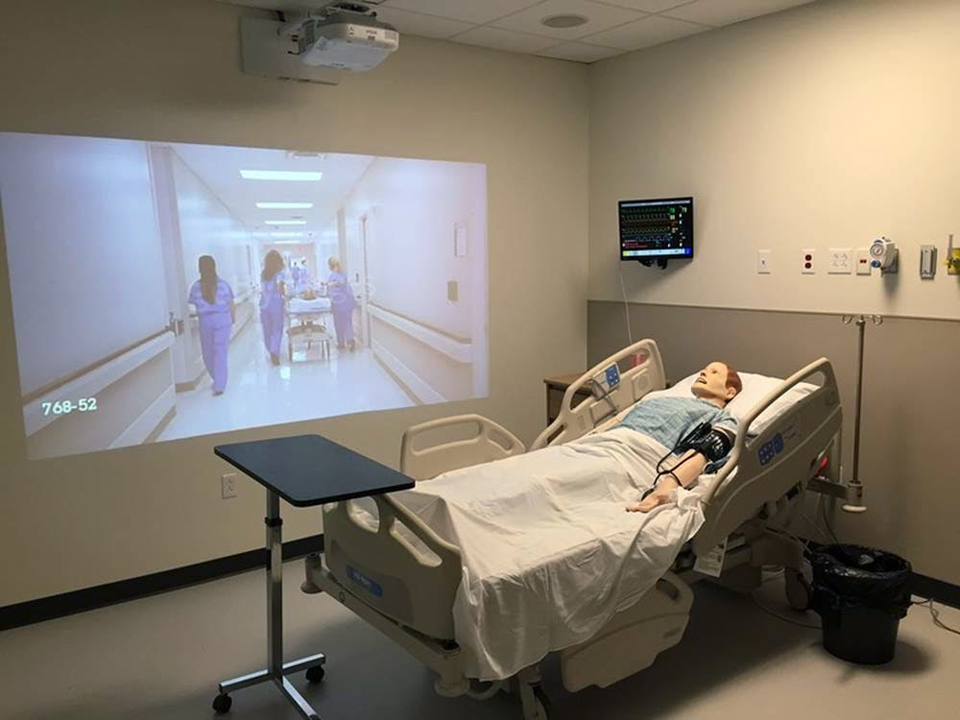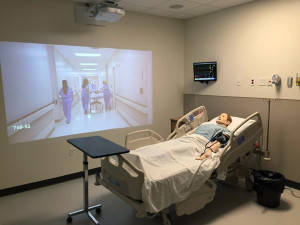

A simulation video plays in one of the mock hospital rooms in Libermann Hall. Nursing students now have a space to practice responding to medical situations.
By Carolyn Conte | The Duquesne Duke
On the fifth floor of Libermann Hall, Duquesne nursing students rush to deliver a baby after its mother goes into shock, her temperature dropping and her weak pulse beating rapidly. The catch? Both patients are plastic.
On November 30, the School of Nursing unveiled its brand-new simulation center, complete with lifelike mannequins and all the high-tech equipment students will use in their careers one day.
“When I was in nursing school we did not have such labs,” Assistant Dean Cherith Simmer said. “Having a center like this is essential to nursing. Patients expect excellent care.”
Dean Mary Ellen Glasgow, who refers to the rooms as “dress rehearsals,” said she supports the use of simulation in education because nurses are often put in emergency situations and need to know how to respond.
Nursing major Zachary Neal, 19, said he has not used the center for very long, but he thinks the simulations will prepare him for the professional world.
“They really help, it does feel real,” Neal said.
Undergraduates and nursing practitioners can now use the simulation center for class learning and tests in their Fundamental Skills and Health Assessment courses.
Nursing major Breanna Crisci, 19, has taken part in a “doctor’s office” simulation in the center.
“[It’s] definitely great practice,” Crisci said. “You knock on the patient rooms and the ‘patient’ student even wears the [hospital gown].”
The center includes replica care units like the rooms at a doctor’s office, a debriefing room where students can watch and analyze tapes of themselves performing procedures, a medication room where students can practice measuring out doses, and a control room where professors can command the mannequins.
There are also two simulation rooms with blank walls. Professors can project videos on the walls that show a realistic emergency scene in a hospital. Students then have to respond to the scenarios, using clues such as a drop in blood pressure from one of the mannequins to guide their actions.
Professor Rosanna Henry, director of learning and the simulation center, said the students who used the center over the summer, before its grand opening, became immersed in the simulations.
“I’d have to ask if they even notice the screen,” she said.
While the majority of this equipment has been at Duquesne since 2001, the nursing school moved it to different rooms and buildings as the school grew, Glasgow said. In just the last three years, enrollment has risen by 42 percent and nursing students now comprise 1,003 of the almost 6,000 undergraduate students at Duquesne.
Increasing enrollment is challenging the school to create more learning spaces, according to Henry. Based on her previous experiences at Drexel University, Glasgow decided that Duquesne’s students needed a dedicated practice area.
“We needed a new lab,” explained Glasgow. “We talked about it, and then Rosanna and I worked with the architects to design the new space.”
The school is also modernizing through the increased use of iPads and electronic textbooks.



